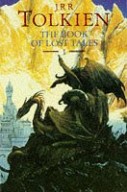Présentation
The Book of Lost Tales contiennent les premiers écrits de fiction de Tolkien se rapportant à son Légendaire. Précédé d’une Preface et suivi d’un appendice étymologique sur les noms, d’un Short Glossary of Obsolete, Archaic and Rare Words et d’un index.
The Book of Lost Tales (1915-1920), décrit comme l’ouvrage du marin Ottor Wæfre (Eriol) ou Ælfwine, est la première expression, hormis quelques poèmes, des légendes des Elfes, a été publiée en deux parties, dans Home1 et Home2. Home1 contient les Contes qui vont de The Music of the Ainur au Conte non rédigé de Gilfanon, intitulé par l’éditeur Gilfanon’s Tale : The Travail of the Noldoli and the Coming of Mankind. Pour le détail des Contes publiés, voir la Synopsis de M. Devaux.
Home1 reproduit plusieurs poèmes associés au Légendaire, et datant de 1914-1916 : Mar Vanwa Tyaliéva, Kortirion among the Trees, Habbanan beneath the Stars, Tinfang Warble, Over Old Hills and Far Away, Kôr, A Song of Aryador et Why the Man in the Moon came down too soon.
L’index étymologique est composé d’extraits du lexique de Qenyaqetsa et d’I·Lam na·Ngoldathon.
Enfin, deux dessins de Tolkien sont reproduits : I Vene Kemen, en frontispice, et un schéma des Grandes Terres (p. 81), redessiné à partir du manuscrit de The Theft of Melko.
Quatrième de couverture
The History of Middle-Earth
Volume 1
compiled by CHRISTOPHER TOLKIEN
The Book of Lost Tales stands at the beginning of the entire conception of Middle-earth and Valinor for the Tales were the first form of the myths and legends that came to be called The Silmarillion. Embedded in English legend and English association, they are set in the narrative frame of a great westward voyage over the Ocean by a mariner named Eriol (or AElfwine) to Tol Eressëa, the Lonely Isle, where Elves dwelt; from them he learned their true history, the Lost Tales of Elfinesse. In the Tales are found the earliest accounts and original ideas of Gods and Elves, Dwarves, Balrogs and Orcs; of the Silmarils and the Two Trees of Valinor; of Nargothrond and Gondolin; of the geography and cosmogoly of the invented world.
In these Lost Tales we have the scholar joyously gambolling in the thickets of his imagination… a Commentary and Notes greatly enrich the quest.
The Daily Telegraph
afford us an almost over the shoulder view into the evolving creative process and genius of J.R.R. Tolkien in a new, exciting aspect… the superb, sensitive and extremely helpful commentary and editing done by Christopher Tolkien makes all this possible.
Mythlore
Table des matières
| Foreword |
1
|
|
| I. |
THE COTTAGE OF LOST PLAY Notes and Commentary |
13 21 |
| II. |
II THE MUSIC OF THE AINUR Notes and Commentaries |
45 49,60 |
| III. |
THE COMING OF THE VALAR AND THE BUILDING OF VALINOR Notes and Commentary |
64 79 |
| IV. |
THE CHAINING OF MELKO Notes and Commentary |
94 106 |
| V. |
THE COMING OF THE ELVES AND THE MAKING OF KÔR Notes and Commentary |
113 129 |
| VI. |
THE THEFT OF MELKO AND THE DARKENING OF VALINOR Notes and Commentary |
140 155 |
| VII. |
THE FLIGHT OF THE NOLDOLI Notes and Commentary |
162 169 |
| VIII. |
THE TALE OF THE SUN AND MOON Notes and Commentary |
174 195 |
| IX. |
THE HIDING OF VALINOR Notes and Commentary |
207 219 |
| X. | GILFANON’S TALE: THE TRAVAIL OF THE NOLDOLI AND THE COMING OF MANKIND |
229
|
|
Appendix: Names in the Lost Tales – Part I Short Glossary of Obsolete, Archaic, and Rare Words Index |
246 274 276 |

